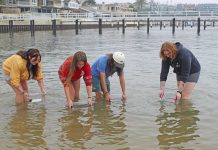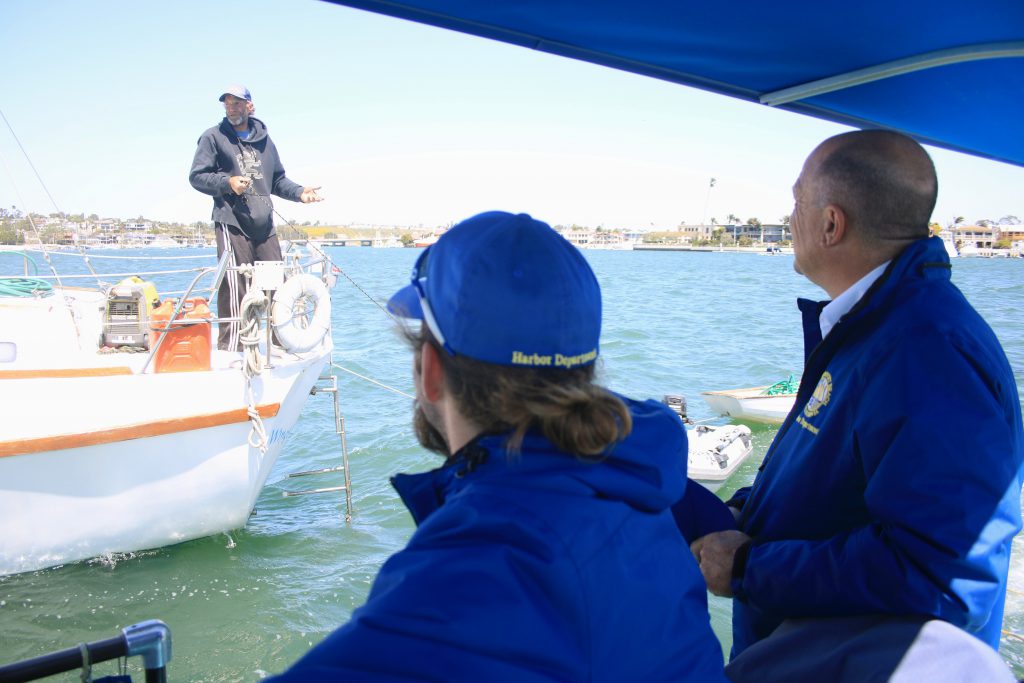
— Photo by Sara Hall ©
Newport Harbor users are likely to see them out on the water, decked out in blue jackets and caps, driving a low-wake catamaran coach patrol boat inscribed with the word “Harbormaster” in all caps, possibly scooping trash out of the water, inspecting the mooring fields, or maybe shooing sea lions off vessels.
They are the harbor service workers that make up the Harbormaster team in the relatively new, restructured city Harbor Department.
Their job entails a variety of work, both out on the water and in the office, explained Harbormaster Kurt Borsting in an interview last week.
On April 10, a slightly windy, but surprisingly busy Wednesday for this early in spring, the team had a mixture of assignments and patrol events.
On land, on the dock and in the office, the day’s dockmaster, Harbor Service Worker Lead Ryan Sanford, took reservations for a few city slips, checked in some boats, looked over Marina Park amenities, input information into the computer system, and more.
On water, in one of the harbormaster department’s boats during an hour-long patrol, Harbor Service Worker Lead Ned Lyon checked mooring lines, shooed some sea lions off a boat, provided information to several harbor users, towed a couple of stand up paddle boarders and someone in a rowboat, picked trash out of the water, and more.
The Harbor Department, recently created by merging other divisions and responsibilities, is based out of Marina Park on the Balboa Peninsula.
Every morning starts with a quick huddle with the team leads. They talk about what’s been happening in the harbor and where they want to focus their field time (like checking mooring lines after windy days, etc.).
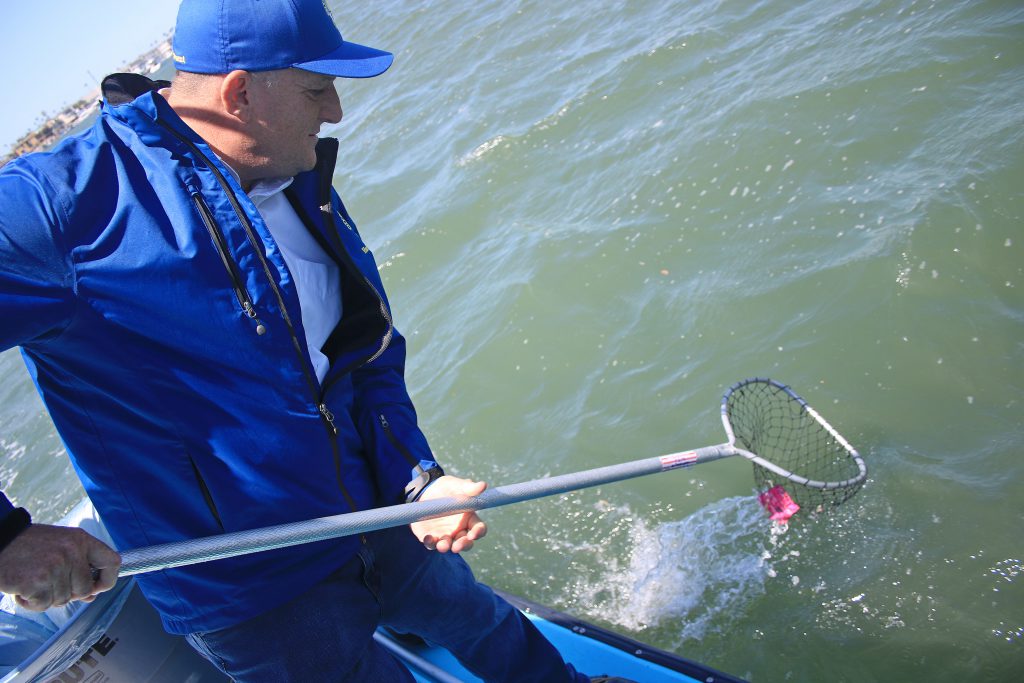
— Photo by Sara Hall ©
During business hours, there is almost always at least one harbor team member on the water and at times all three harbormaster boats are out on patrol.
Patrol is an all-encompassing phrase for their line of work, Lyon said.
It could mean contact with the public if someone flags them down for help, or to ask for information or report something.
During a recent patrol on April 10, a live aboard waved Lyon and Borsting down to ask about time limits on the dock, another alerted them to a boat to check out. It was a windy day, and Lyon also towed two stand up paddle boarders and a rowboat that were struggling against the current.
Patrol also includes picking up any trash they see floating in the water, particularly large debris after a heavy rain.
“We’re doing our job trying to keep the harbor clean,” Lyon said after he fished out a chunk of Styrofoam floating in the water.
Borsting also caught a small piece of plastic during the patrol on April 10. Lyon said he’s seen bigger items get washed down as well, including tires and large appliances.
Their day patrolling the water also includes shooing away sea lions who have hauled out on boats, which also happened on April 10.
“They don’t want to see us,” Lyon said, as he sprayed water on a few sea lions that were sunning themselves on the back of a yacht in the H mooring field.
The pinnipeds barked and jumped into the water, but even after hanging out for a few minutes (to encourage the famously lazy animals to give up and swim away) and putting the wooden deterrent fixture (that was tied to the boat) back up, at least one was seen flopping back up after the harbormaster boat was a good distance away.
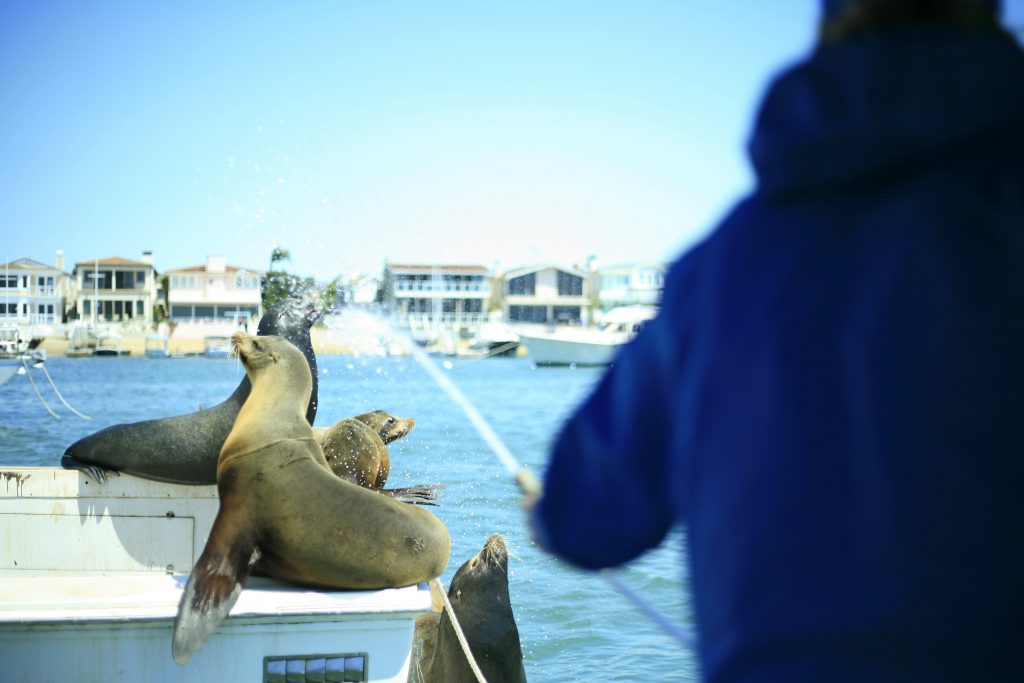
— Photo by Sara Hall ©
They follow-up with the mooring permittee about other deterrents that might help, Borsting said. At a recent Harbor Commission meeting, National Oceanic and Atmospheric Administration Fisheries officials recommended SealStop, which makes it uncomfortable, but doesn’t harm the animals.
“It’s like stepping on your kids’ Legos,” NOAA California Stranding Coordinator Justin Viezbicke said at the meeting.
SealStop can be installed on boats, docks. buoys and other surfaces and “consists of unobtrusive, compact units with rotating spinner elements, slightly larger than the size of a tennis ball,” according to the company’s website.
Harbormaster team members patrol of Newport Harbor also includes informing and educating the public, like telling paddle boarders they need a life jacket on board or reminding boaters that the harbor speed limit is 5 knots or no wake zone.
“It could be anything, keep your eyes peeled,” Lyon said.
The team also regularly checks public dock time limit areas, part of a new plan to better enforce the rules and obtain better compliance.
“We are trying to improve our process of enforcing (time limits) on the docks,” Borsting said. “The philosophy that we’re taking is we want to educate and enforce, so that people get an opportunity to make sure they understand what the rules of the harbor are and then, concurrent to that, we’re holding everybody accountable to those rules.”
They tested use of the time limits in March by photographing vessels tied up at the 15th Street dock over three days, noting CF numbers and distinguishing characteristics. The daily report would also include the time of day and the staff member who made the report. They found that many vessels in the 72-hour time limit overstayed the allotted time.
“The good news is that it’s a very popular public resource,” Borsting said, but “the principle really needs to be that this is a shared, community, free-of-charge resource… And we all need to be respectful of that.”
The solution may be a mixture of education, better enforcement, and adjusting the time limit areas to fit the needs of users.
To start things off at the 15th Street dock, they’ve placed sandwich board signs, informing users of the time limits the municipal code rules, and alerting users that they will be enforced.
They need to give people clear rules so they know what to expect and how to follow them, Borsting said.
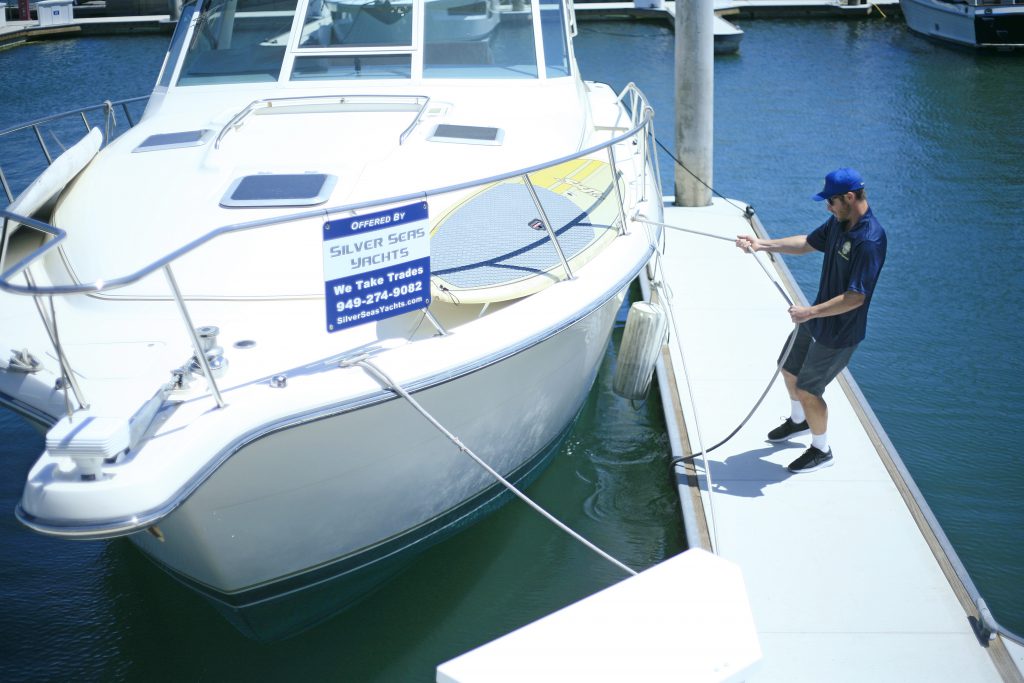
— Photo by Sara Hall ©
Boats aren’t meant to be stored there, Borsting said, it’s a public dock and is meant to be shared by the community. It’s not fair to other harbor users if the same boat is continuously tied up, almost never moving, and monopolizing the space, he commented.
“We’re going to be actively monitoring and enforcing,” Borsting confirmed. “Us being active on the dock is going to lead to better compliance.”
Previously, it had been monitored, but actively enforcing the rules had fallen by the wayside, he noted. It’s now more of a priority, he said.
During a morning check on April 10, about 20 boats tied up at the 15th Street dock received a notice about the time limit and were documented by Code Enforcement Supervisor Matt Cosylion.
The process includes daily checks and reports, and if a vessel hasn’t moved in three days it will be subject to impound.
With the Title 17 Harbor Code review currently underway, they are also looking at whether or not it’s the right mix of time limits (72, 24, and 3 hours, and 20 minutes) Boaters at a recent Title 17 meeting supported the suggestion of adding a 12-hour section.
If they continue to get the word out, educate the public, monitor the docks, and actively enforce the time limits, they should see results, Borsting hoped.
“And if this doesn’t work, we’ll try something else,” Borsting concluded.
Along with checking the public docks, a big part of the job for harbor workers in the field is checking the moorings.
In the city managed inventory, there are 1210 total moorings: 435 onshore, 578 offshore, and 197 through other parties.
Harbor service workers patrol the mooring fields, checking lines, making sure the boats aren’t getting too close to each other, noting any work the owner may need to do, like tightening the mooring ball or adding sea lion deterrents.
Every day they do a vacancy check, and note if any moorings are vacant, Lyon said. If a mooring is vacant for 30 days or more, it can be temporarily rented out.
Harbor staff use a citywide work order program called quest, which allows them to easily enter reports while still on the water. Service workers have an iPad mounted on the harbormaster boats so they can quickly input an order if they notice a mooring ball that has fallen out of position, or a sign that needs to be replaced, or anything that needs additional follow up.
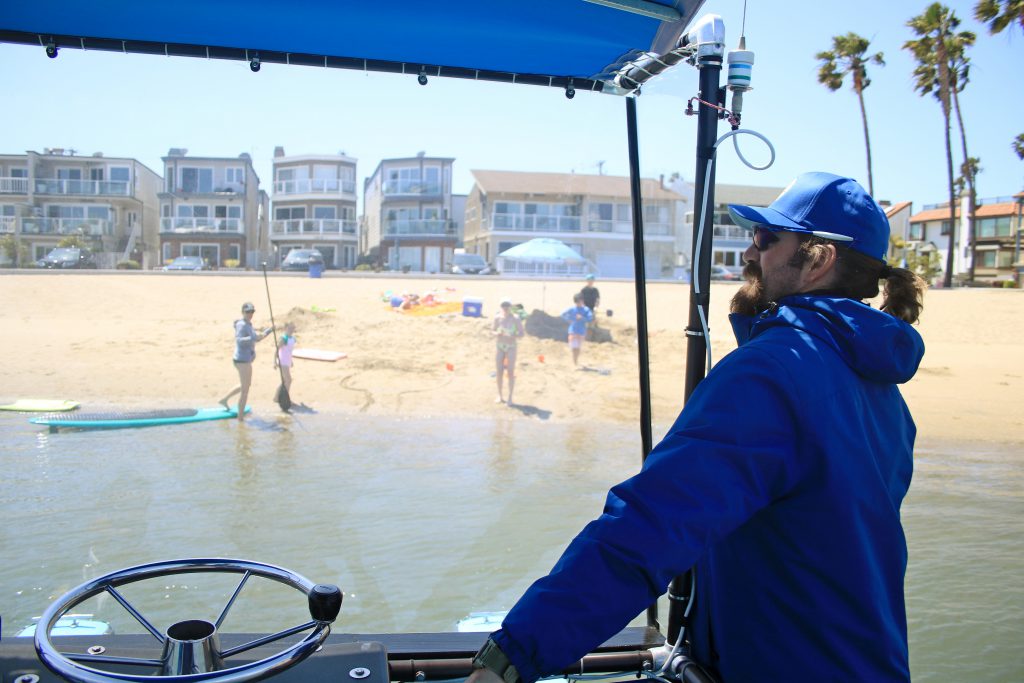
— Photo by Sara Hall ©
The goal is to have the largest presence that they can on the water, in all areas of the harbor, Borsting said.
“We want to be present in each of the mooring fields, in each of the different neighborhoods,” Borsting said. “It can’t be just in front of our front door.”
The city also has several complimentary public pump-out stations, Borsting noted. The department regularly checks on them, he added, to ensure that they are working properly and in good condition.
“It’s very important to us that those are working and in good order because that’s what encourages people to be responsible,” Borsting noted.
On the landside, the dockmaster will take reservations, communicate with the boaters, greet them when they arrive at Marina Park, assist with lines and tying the vessel up to the slip, provides some dock information (about getting shore power, amenities, pump-out system at the slip, etc.), and more.
There are 23 guest slips at Marina Park available for short-term rental. Of those, 21 of the slips are 40-foot slips and two are 55-foot slips, which can hold a vessel up to 65 feet. Charges are based on the slip or boat length, whichever is greater. They have slips that can accommodate either 30- or 50-amp power.
The main focus is on customer service, Sanford said.
The dockmaster will perform the pump-out service, available at the slip, for the guest boater (or assist them with the process) at Marina Park. Some people like to do it themselves, Sanford added, but if they’ve never done it before he likes to make sure it gets done properly.
“There are some people that don’t want us to deal with that,” Sanford noted.
Guests also get a key that gets them into the bathroom (with a shower) and complimentary laundry room. They are private just to the renters, Sanford explained.
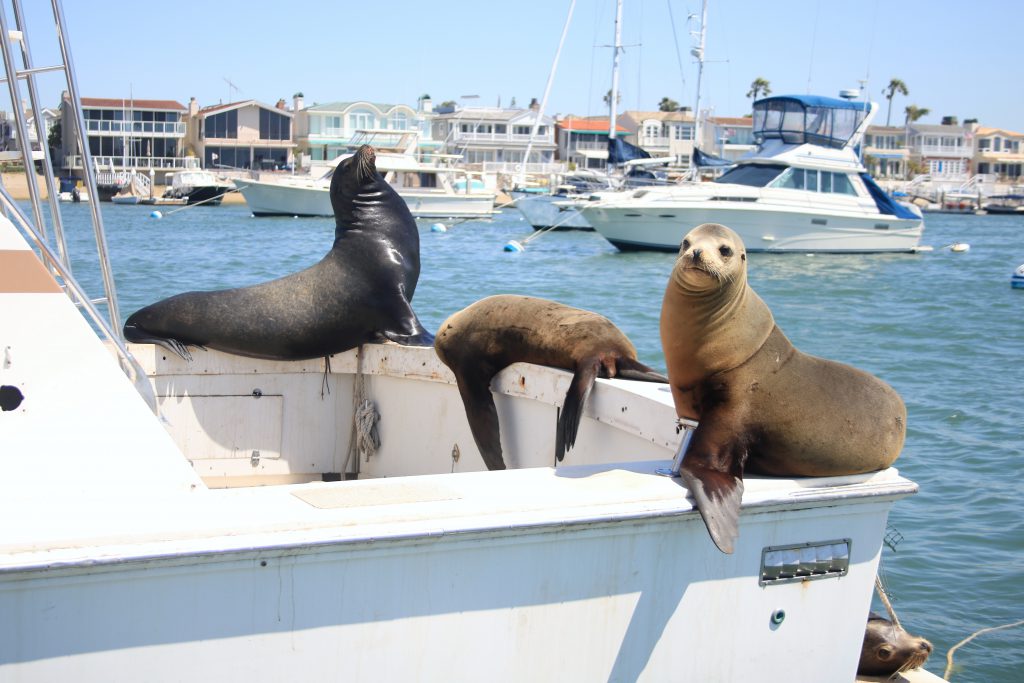
— Photo by Sara Hall ©
The complimentary washer and dryer are also an unusual extra touch, Borsting added.
“It’s a really unexpected level of customer service at a guest marina,” Borsting said. “It’s nice as a visiting marine (to have these amenities).”
The most common length of stay is three to five days, Sanford said. The maximum is 30 days in a 6-month period.
Locals can get a lot out of Marina Park, Borsting continued. During the high winds last week, at least one local boater brought his vessel in and parked it at one of the slips.
Local and regional yacht clubs sometimes do group events, Borsting said. For clubs based out of Newport Harbor, it’s like a “stay-cation,” he joked.
“I think we’re going to see more and more of that as the summer picks up,” Borsting said.
“It’s shocking how busy we are in the summer time,” Sanford said.
Most people make reservations, which can be made six months ahead of time, Sanford noted. Last minute arrivals without reservations are also accepted, although they can’t guarantee there will be any slips available, particularly during the busy season, he added.
The team is currently looking into how to provide additional service to the mooring community on some of the lighter days, Borsting explained. They are in the process of developing a trial program where a mooring permit holder would be able to bring their boat in for a couple of hours to do certain tasks that are more difficult when on a mooring, like wash down the boat or meet with a possible service provider or vendor.
“Being able to set up those appointments where people can do it from a fixed environment off of an available a dock would be more convenient for most folks,” Borsting said.
It would be based on availability and only for a few hours, he emphasized.
“We are going to work out the details so that we’re very clear on what’s allowed,” and what isn’t (like heavy work that could be disruptive), Borsting explained.
They are in the process of putting together a trial program and hope to offer something along those lines soon, he added.
It would serve the entire boating community in Newport Harbor. The aim is to be hospitable to the local harbor community, but still serve the core mission of the guests slips.
“It’s the magical middle ground,” Borsting said.
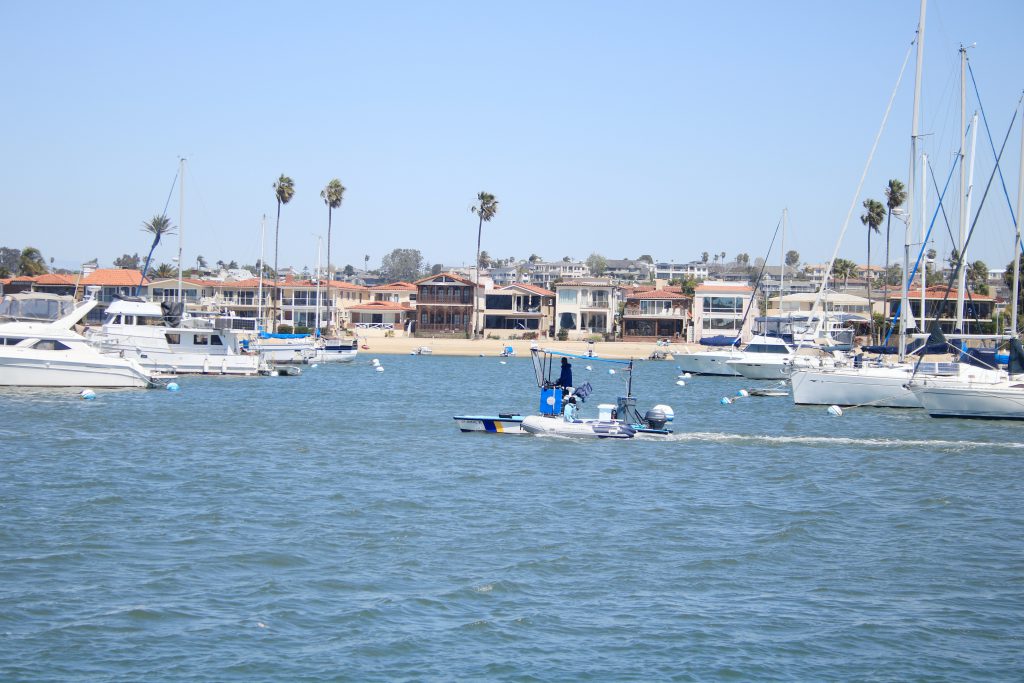
— Photo by Sara Hall ©
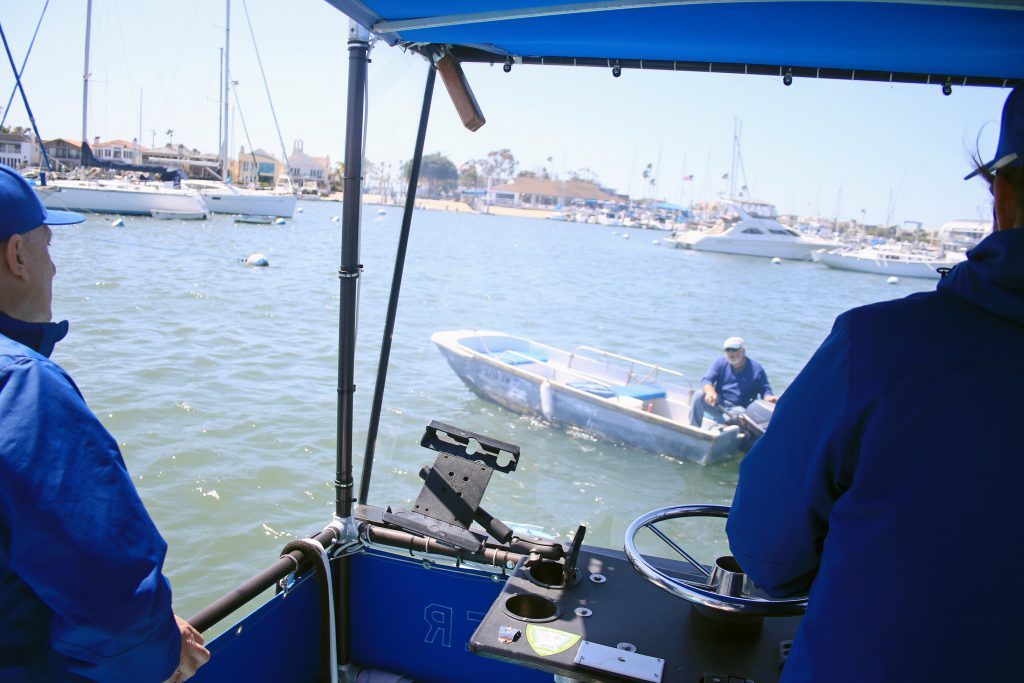
— Photo by Sara Hall ©
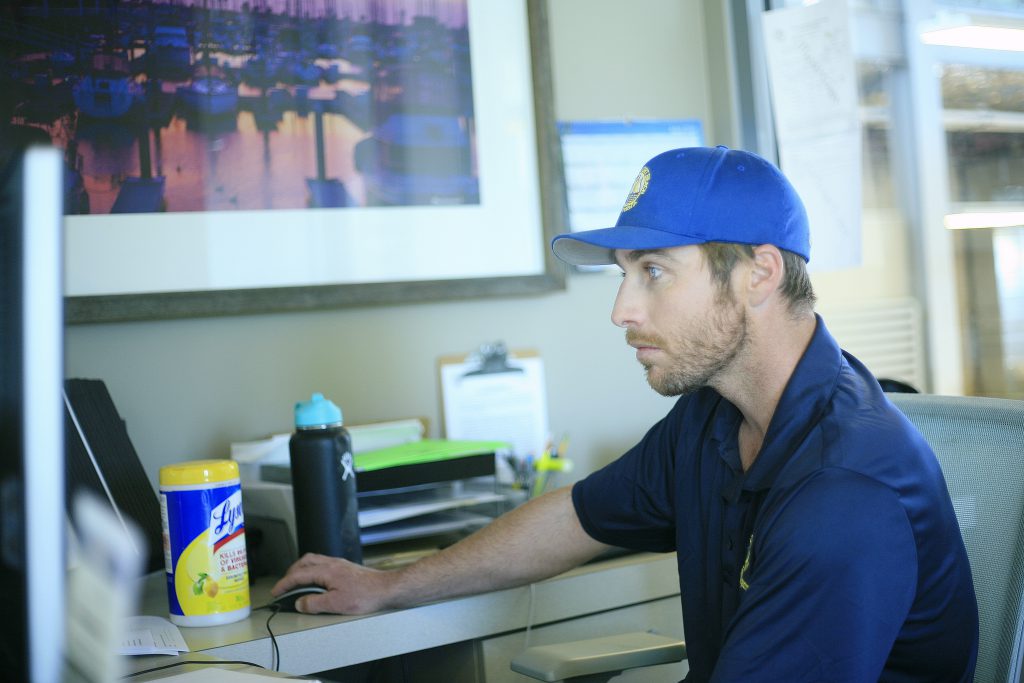
— Photo by Sara Hall ©
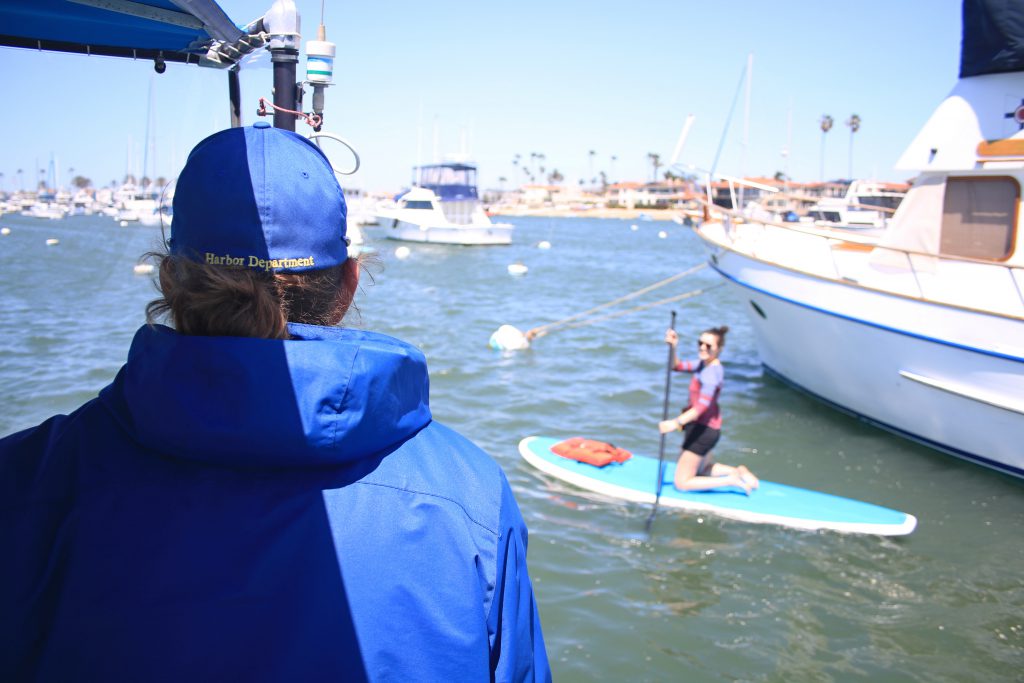
— Photo by Sara Hall ©
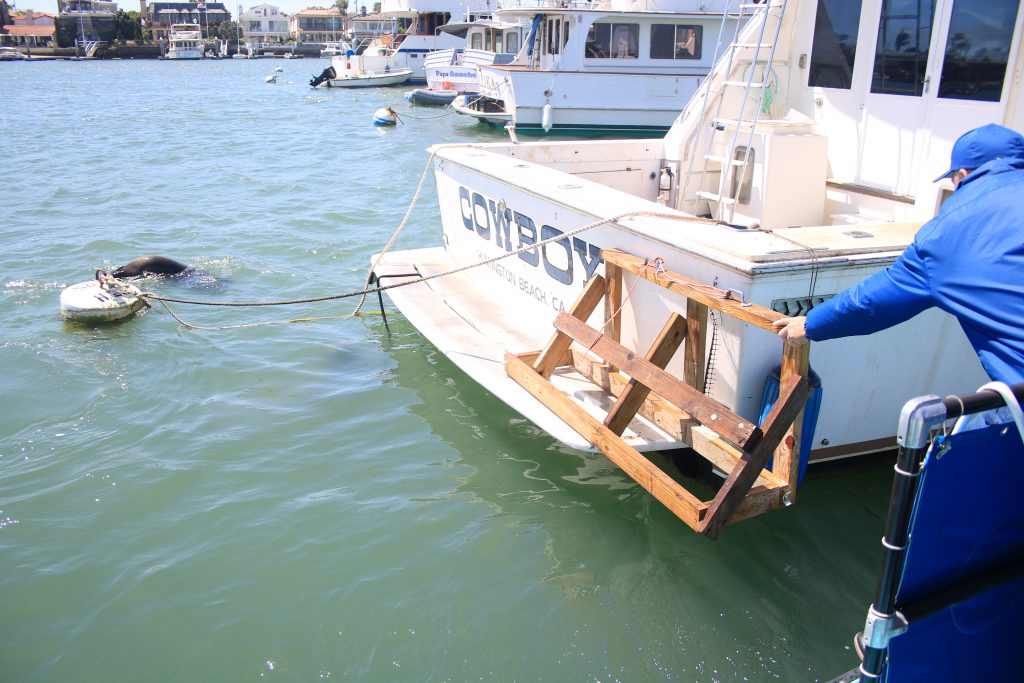
— Photo by Sara Hall ©



